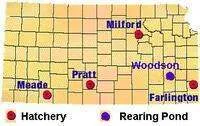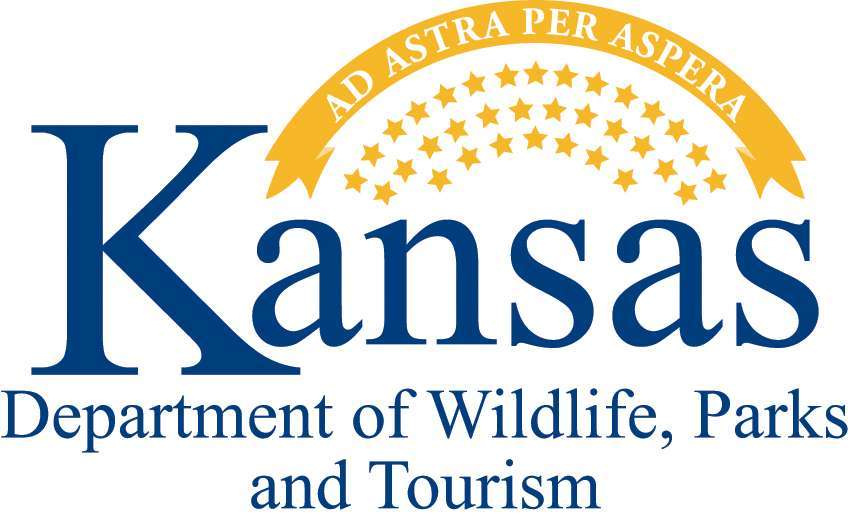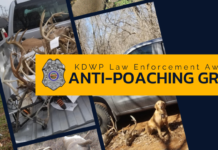PRATT – In March, Kansas Department of Wildlife, Parks and Tourism (KDWPT) fisheries biologists and other staff collected nearly 100 million walleye eggs.
Thanks to the Kansas Walleye Initiative, a record percentage of the walleye and saugeye hatched from those eggs will likely end up on the hooks of Kansas anglers.
“We’ve been having some great success, and the program is only four or five years old,” said Scott Waters, KDWPT fisheries biologist and chairman of the walleye committee. “It’s already leading to more catchable walleye.”
The program began in 2015, with meetings between fisheries biologists and a variety of researchers and hatchery staff. Waters was also quick to thank the Kansas Wildlife, Parks and Tourism Commission for ongoing support for the program.
The initiative has led to the following:
Higher survival rate for stocked fingerlings
One of the program’s goals is to increase the size of stocked walleye fingerlings from about 1.25 inches to 1.7 inches, giving fingerlings a chance to develop scales before being stocked and a better chance of survival. The increased size makes it easier for them to find food, and scales protect against fatal infections.
Bigger and better walleye for stocking
The Kansas Walleye Initiative has led to hatcheries implementing an intensive walleye culture process that has increased production of “intermediate” walleyes that are 8 to 10 inches long when stocked. These fish are stocked in the fall, have very high survival rates and are well on their way to being of a desirable size for anglers. Last year, about 20,000 intermediates were produced and stocked in Kansas lakes and reservoirs. Waters said the department’s goal of producing 75,000 intermediate-sized walleye is within sight.
Specialized management plans
Largely depending on their capabilities, reservoirs and lakes are now classified and managed in four categories:
Harvest lakes are managed to allow anglers to harvest walleye or saugeye and have a 15-inch minimum length limit.
Trophy waters are managed to give anglers their best chance at a walleye or saugeye of trophy-sized proportions, using 18- or 21-inch minimum length limits and sometimes reduced creel limits.
Brood walleye lakes are managed to provide good fishing yet a ready supply of healthy walleye eggs for the program.
Biological control lakes are managed to keep good numbers of big walleye and saugeye in the water to help control problematic species, like white perch.
Waters said the plan is to keep at least one lake from each category within an easy drive of most Kansas anglers.
Stocking based on priority and potential
Kansas reservoirs and lakes are now more closely studied and ranked based on walleye or saugeye need and potential. Rather than randomly distributing fish for stocking, fry, fingerlings and intermediates are sent to where they’re most needed, yet likely to survive and thrive.
Funding the project
The Kansas Walleye Initiative’s goals are becoming realities because of significant funding improvement for the state’s walleye hatchery program. High on that list is a $2 million specialized walleye facility being constructed at the Meade Fish Hatchery. Another $225,000 has been spent to improve specialized equipment at the department’s Milford Fish Hatchery. There’s also an annual budget of $280,000 to cover the enhanced feed and energy costs, plus the purchase of fingerlings from private fish producers when needed.
Two full-time employees have been hired specifically for the program and funding to hire part-time employees, when needed, is also available.
Waters said the majority of the funding comes from fishing license revenue and the Dingell-Johnson fund, derived by federal excise taxes placed on fishing gear. D-J grants can only be used on projects that improve fishing and require 25 percent matches, provided by license revenue.
“As usual, everything goes back to the anglers really being the ones who pay for projects,” said Waters. “We should get a really good return on the investment. We see an excellent future.”
###
Increased Pressure on Public Waterfowl Hunting Areas Discussed at Wildlife, Parks and Tourism Commission Meeting
PRATT –At the March 25, 2021 public meeting, Kansas Wildlife, Parks and Tourism Commissioners discussed issues raised by Kansas waterfowl hunters about the increase in nonresident waterfowl hunters during the 2020-2021 season. At the request of commissioners, Tom Bidrowski, Kansas Department of Wildlife, Parks and Tourism (KDWPT) migratory gamebird program manager, presented data on the number of resident versus nonresident hunters on public waterfowl hunting areas. According to Kansas Duck State Waterfowl Permit sales, non-residents made up 38 percent of Kansas waterfowl hunters last season – up from 21 percent in 2011. However, that ratio varies, depending on the wildlife area.
Several commissioners pushed for a solution to the problem before the upcoming season. Possible solutions discussed include limiting the number of days non-residents can hunt waterfowl at some Kansas public areas and/or limiting the number of non-residents on such areas via a lottery drawing. The topic will see more discussion at the commission’s April 29 meeting.
Other items of note addressed during the March 25 meeting:
Season dates, limits for 2021-2022 waterfowl seasons.
Bidrowoski presented proposed season dates and limits for upcoming duck and goose seasons. The proposed dates and limits follow a similar framework of recent seasons and go to a vote at the April 29 meeting.
An exception could be the weekend before regular duck seasons open, when youth, people with disabilities, veterans and active military are allowed to hunt.
Commissioners discussed changes that could reduce conflicts and ensure youth experience high-quality hunts.
Increased opportunities for youth, parents
KDWPT staff and commissioners continued discussion about raising the maximum age of youth participating in youth seasons to 17. Currently, the maximum age is 16 for pheasant, quail, turkey and deer youth seasons, but 15 for waterfowl youth seasons. The change being considered is meant to increase opportunity and make regulations consistent.
Another recommendation will remove the requirement that adults accompanying youth hunters during the youth waterfowl season be licensed and have appropriate stamps. Again, the goal is to increase opportunities for youth and simplify regulations.
Jeff Prendergast, KDWPT small game specialist, recommended allowing youth hunters to take full bag limits of pheasant (four roosters per day) and quail (eight per day) during the youth weekend. Currently, youth season daily bag limits are half those allowed during the regular pheasant and quail seasons.
Continuous prairie chicken season
Kent Fricke, KDWPT small game program coordinator, presented staff recommendations to run the 2021-22 greater prairie chicken season from Sept. 15 through Jan. 31. Previously, the season has ran from Sept. 15 through Oct. 15, and the third Saturday of November through Jan. 31.
The early season segment, when hunters typically hunt greater prairie chickens with dogs, has gained in popularity and this change would increase those opportunities. Research shows hunters annually harvest no more than 3 percent of the Kansas greater prairie chicken population, so eliminating the split is not expected to have any impact on prairie chicken populations. Fricke said northcentral Kansas, where greater prairie chicken numbers remain strong, receives the most hunting pressure.
State park kiosks
Linda Lanterman, KDWPT Parks Division director, updated the commission on the plans to install electronic kiosks in designated Kansas state parks this year. The kiosks will allow park users to purchase permits with credit cards, replacing the cumbersome and inefficient unmanned “Iron Rangers,” which require cash deposits. The kiosks will provide users a receipt that can be placed on the dash of their vehicle.
The Latest from Kansas Department of Wildlife, Parks and Tourism News
Inaugural Great Kansas Fishing Derby Kicks Off May 1
PRATT – A Kansas angler’s prized catch may actually be worth a prize this spring and summer. The first-ever Great Kansas Fishing Derby will run May 1 to July 31, 2021, with at least 500 specially tagged fish located in up to 37 public waterbodies in Kansas. The Great Kansas Fishing Derby is sponsored by the Kansas Department of Wildlife, Parks and Tourism (KDWPT), Kansas Wildscape Foundation, the Bass Pro-Cabela’s Outdoor Fund and many local retailers across Kansas.
“The main goal is to get more people fishing. We had a lot of anglers join the party in 2020 and we want them to keep participating,” said David Breth, KDWPT sportfishing education coordinator. “We also want to make sure businesses know about their local fishing waters and just how many people visit these nearby fishing spots.”
How It Works
Pre-registration is not required, and participation is free, though normal fishing license requirements remain in effect. To get your Kansas fishing license, visit kshuntfishcamp.com or download KDWPT’s mobile licensing app, “HuntFish KS,” here https://ksoutdoors.com/License-Permits/HuntFish-KS.
Anglers who catch a tagged fish as part of the Great Kansas Fishing Derby must register the tag number at ksfishderby.com. A follow-up communication will notify the angler of what they’ve won and where to claim the prize. Ksfishderby.com will also allow anglers and non-anglers to register to win additional prizes through weekly drawings.
Businesses across Kansas are supporting the Great Kansas Fishing Derby by providing prizes in the form of gift cards, merchandise and more – including a city zoo that has pledged an annual family pass. KDWPT will also contribute gift cards, which can be credited toward any department-issued license or permit, or magazine subscription. KDWPT gift cards are also honored at all Kansas state parks.
Where To Fish
All participating waterbodies are open to the public and managed in whole or in-part by KDWPT. Also included in the list of participating waters are ponds and lakes currently enrolled in KDWPT’s Community Fisheries Assistance Program (CFAP). By leveraging funding from federal excise taxes on fishing equipment, KDWPT leases public access – at no additional cost to the public – to gorgeous waters that once required special county, community or city permits.
A complete list of waters with fish tagged for the Derby will be posted on ksfishderby.com on April 30.
“We’ll have popular sportfish tagged, like bass, crappie and walleye,” said Breth.
“We’ll also have some non-sportfish like carp, gar and drum. We have people who like to fish for them and a lot who also participate in bow fishing. There will probably be some big bluegill tagged because we’d love to see kids win some of these prizes, too.”
Most tagged fish will meet legal length limits and can be legally kept. However, anglers may release their catch if they first remove the tag (see ksfishderby.com for instructions).
Businesses and groups interested in sponsoring tagged fish for this year’s Derby can find sponsorship details at ksfishderby.com. Breth added that more than 500 fish could be tagged as sponsorship grows. He also hopes the Derby becomes an annual event, as it’s become in Washington state.
“They’ve been doing it with trout, which they raise in hatcheries, since 2016,” he said. “It’s really popular with anglers and (sponsoring) vendors. It keeps growing every year for them, so we’re hoping that will be the case here.”
For more information on fishing in Kansas, visit ksoutdoors.com/Fishing.
For more on the Derby, visit ksfishderby.com.
###





